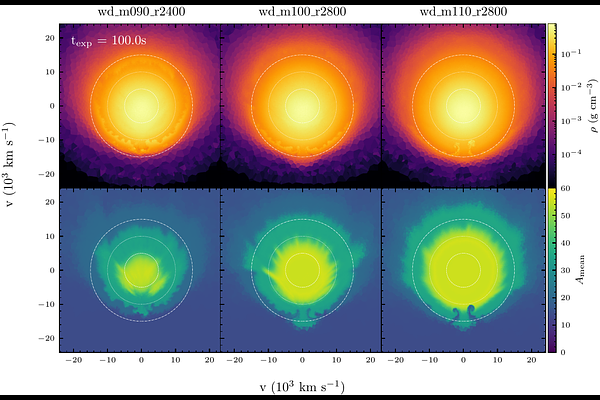The asymmetry of white dwarf double detonations and the observed scatter around the Phillips relation

The asymmetry of white dwarf double detonations and the observed scatter around the Phillips relation
Alexander Holas, Friedrich K. Roepke, Rüdiger Pakmor, Fionntan P. Callan, Josh Pollin, Stuart A. Sim, Christine E. Collins, Luke J. Shingles, Javier Morán-Fraile
AbstractRecent Type Ia supernova (SN Ia) simulations featuring a double detonation scenario have managed to reproduce the overall trend of the Phillips relation reasonably well. However, most, if not all, multidimensional simulations struggle to reproduce the scatter of observed SNe around this relation, exceeding it substantially. In this study, we investigate whether the excessive scatter around the Phillips relation can be caused by an off-center ignition of the carbon-oxygen (CO) core in the double detonation scenario and if this can help constrain possible SN Ia explosion channels. We simulated the detonation of three different initial CO white dwarfs of $0.9$, $1.0$, and $1.1\,M_\odot$, artificially ignited at systematically offset locations using the Arepo code. After nucleosynthetic postprocessing, we generated synthetic observables using the Artis code and compared these results against observational data and models of other works. We find that our simulations produce synthetic observables well within the range of the observed data in terms of viewing angle scatter. The majority of the viewing angle variability seems to be caused by line blanketing in the blue wavelengths of intermediate-mass elements and lighter iron-group elements, which are asymmetrically distributed in the outer layers of the ashes. Our results suggest that although the off-center ignition of the CO introduces substantial line of sight effects, it is not responsible for the excessive viewing angle scatter observed in other models. Instead, this effect seems to be caused by the detonation ashes from the rather massive helium (He) shells in current state-of-the-art models. Further reducing the He-shell masses of double detonation progenitors may be able to alleviate this issue and yield observables that reproduce the Phillips relation.